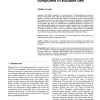Free Online Productivity Tools
i2Speak
i2Symbol
i2OCR
iTex2Img
iWeb2Print
iWeb2Shot
i2Type
iPdf2Split
iPdf2Merge
i2Bopomofo
i2Arabic
i2Style
i2Image
i2PDF
iLatex2Rtf
Sci2ools
IJCAT
2006
2006
Interaction design patterns for computers in sociable use
: This article contributes to a growing body of design patterns in interaction design for cooperative work, while also describing how to go from field studies to design patterns. It focuses sociable face-to-face situations. The patterns are based on field studies and design work in three sociable settings where desirable use qualities were identified and translated into forces in three design patterns for controlling information visibility. Based on the patterns, the design of a multiple-device multimedia platform is described. It is shown that desirable qualities of systems-in-use can be utilized as forces in patterns, which means that traditional qualitative research is highly valuable when documenting design knowledge in patterns. Three classes of interaction design patterns are identified: environments for interactions, means for interaction, and interfaces for interaction. These classes describe types of patterns within a hierarchical model of interaction design.
| Added | 12 Dec 2010 |
| Updated | 12 Dec 2010 |
| Type | Journal |
| Year | 2006 |
| Where | IJCAT |
| Authors | Mattias Arvola |
Comments (0)

